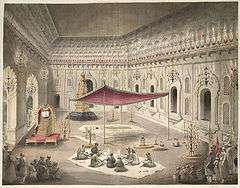Bara Imambara
Coordinates: 26°52′09″N 80°54′46″E / 26.869104°N 80.912885°E
| Bara Imambara | |
|---|---|
|
Bara Imambara facade, Lucknow | |
| Location | Lucknow, Uttar Pradesh, India |
| Built | 1784 |
| Architectural style(s) | Mughal architecture |
Bara Imambara (Urdu: بڑا امامباڑا, Hindi: बड़ा इमामबाड़ा) is an imambara complex in Lucknow, India, built by Asaf-ud-Daula, Nawab of Awadh, in 1784. It is also called the Asafi Imambara.
Bara means big, and an imambara is a shrine built by Shia Muslims for the purpose of Azadari. The Bara Imambara is among the grandest buildings of Lucknow.
Building composition

The complex also includes the large Asfi mosque, the bhul-bhulaiya (the labyrinth), and bowli, a step well with running water. Two imposing gateways lead to the main hall.
Relief measure
Construction of Bara Imambara was started in 1785, a year of a devastating famine, and one of Asaf-ud-Daula's objectives in embarking on this grandiose project was to provide employment for people in the region for almost a decade while the famine lasted. It is said that ordinary people used to work in the day building up the edifice, while noblemen and other elite worked at night to break down anything that was raised that day. It was a project that preceded a Keynesian like intervention for employment generation. Construction of the Imambara was completed in 1791. Estimated cost of building the Imambara ranges between half a million rupees to a million rupees. Even after completion, the Nawab used to spend between four and five hundred thousand rupees on its decoration annually.[1]
Architecture



The architecture of the complex reflects the maturation of ornamented Mughal design, namely the Badshahi Mosque - it is one of the last major projects not incorporating any European elements or the use of iron. The main imambara consists of a large vaulted central chamber containing the tomb of Asaf-ud-Daula. At 50 by 16 meters and over 15 meters tall, it has no beams supporting the ceiling and is one of the largest such arched constructions in the world. There are eight surrounding chambers built to different roof heights, permitting the space above these to be reconstructed as a three-dimensional labyrinth with passages interconnecting with each other through 489 identical doorways. This part of the building, and often the whole complex, may be referred to as the Bhulbhulaya. Known as a popular attraction, it is possibly the only existing maze in India and came about unintentionally to support the weight of the building which is constructed on marshy land. Asaf-ud-Daula also erected the 18 meter (59 foot) high Rumi Darwaza, just outside. This portal, embellished with lavish decorations, was the Imambara's west facing entrance.[2]
The design of the Imambara was obtained through a competitive process. The winner was a Delhi architect Kifayatullah,[1] who also lies buried in the main hall of the Imambara. It is another unique aspect of the building that the sponsor and the architect lie buried beside each other.The roof of Imambara is made up from the rice husk which make this Imambara a unique building
Legend
There is also a blocked (tunnel) passageway which, according to legends, leads through a mile-long underground passage to a location near the Gomti river. Other passages are rumoured to lead to Faizabad (the former seat of power of the Nawabs), Allahabad and even to Delhi. They exist but have been sealed after a period of long disuse as well as fears over the disappearance of people who had reportedly gone missing, while exploring.
See also
- Roomi Darwaza
- Chattar Manzil
- Imambara Shah Najaf
- Imambara Sibtainabad Mubarak
- Chota Imambara
- Imambara Ghufran Ma'ab
- Imambaras of Lucknow
References
- 1 2 Meenakshi Khanna (2007-07-01). Cultural History Of Medieval India. Berghahn Books. p. 82. ISBN 978-81-87358-30-5.
- ↑ "Lucknow City". Laxys.com. Retrieved 2014-02-08.
External links
| Wikimedia Commons has media related to Bara Imambara. |
